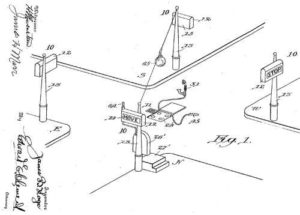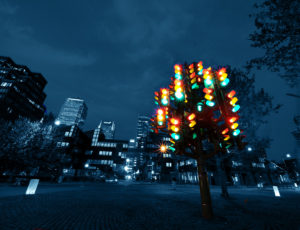One of Robert Frost’s most beloved poems speaks of being faced with choosing one of two roads and taking “the road less traveled.” In the U.S. today, he might have trouble finding a road less traveled—or so it seems with congestion on our highways and byways.
The city of Cleveland faced that dilemma itself when it installed the first electric traffic signal in the U.S. On August 5, 1914, the city turned the switch at the intersection of Euclid Avenue and East 105th Street, and a new era of traffic management was born. The first signal had lighted green signs that read “move” and lighted red signs that read “stop.” The device was operated by a worker stationed in a nearby booth. The inventor, James Hoge, received a patent for his “Municipal Traffic Control System,” which the Cleveland Automobile club described as “destined to revolutionize the handling of traffic in congested city streets….” And it has. Today the U.S. has an average of one traffic light for every ten miles of road!

In 1900, the road system in the U.S. was already well established, with about 2 million miles of roads crisscrossing the landscape. More than a century later, the road network has about doubled to 4 million miles. Of course, most roads in 1900 were one or two lanes wide, and today some interstates have 15 lanes. A more accurate portrayal of our road-system capacity, according to the National Academy of Sciences, is lane miles. The U.S. has about 8.3 million of those, meaning that most roads (76% of all lane miles) are still two-lane rural highways.
One might think that the U.S. is virtually covered in roads. Roads cover about 1.2% of the U.S. surface area (about 0.2 miles of road per square mile of land area), but, of course, the density differs greatly from New Jersey (the highest) to Alaska (the lowest). However, the U.S. isn’t even close to having the world’s highest road densities, ranking 44th among the world’s countries. The average for the 28 countries of the European Union is 2.5 times denser than the U.S. and for Japan is 4.6 times denser than the U.S.

Regardless of how many roads we have, we love to drive on them. In 2019, we drove motorized vehicles—cars, trucks, buses, RVs, motorcycles—3.3 trillion miles, or about 10,000 miles for every person, adult and child, in the U.S. (highway miles dropped in 2020 to 2.9 trillion, no doubt as the pandemic caused us to park our vehicles and stay home). We also spent a lot of time sitting in traffic, yearning for the road less traveled. In 2014, Americans idled in congested traffic for nearly 7 billion hours, at an estimated cost of $160 billion in lost time and wasted fuel. During that waiting, we burned up over 3 billion gallons of fuel, producing the greenhouse gases and other pollutants for no good reason.
The environmental costs of our road system and the mileage we rack up on it are huge. Building roads changes the environment, often fragmenting habitat for wildlife and changing the hydrology of streams. Pollutants discharged from vehicles travel outward from the road surface itself, for some just a matter of a few feet, but for others hundreds of feet. And the impacts vary according to the terrain and climate—elevation, slope, rainfall, soil type and others.
Fortunately, most expansion of the road system in the U.S. today is not by building new roads across undeveloped lands, but by expanding the lanes on existing roads. Consequently, the environmental damage from road building should be lower in the future than in the past, and new guidelines and regulations, based on past experience and ongoing research, help reduce the impact even more.

For those of us who can’t abide sitting in traffic—what my friend Rick Knight calls “the need for speed”—the news isn’t very good. From that first traffic signal in Cleveland in 1914, the U.S. now has over 300,000 traffic lights, and uncounted millions of stop signs. If you find a road less traveled, count your blessings and don’t tell anyone!
References:
American Society of Civil Engineers. 2017. Infrastructure Report Card—Roads. Available at: https://www.infrastructurereportcard.org/wp-content/uploads/2017/01/Roads-Final.pdf. Accessed June 5, 2018.
a. 2017. 1st electric traffic light system installed, August 5, 2014. EDN Network, August 05, 2017. Available at: https://www.edn.com/electronics-blogs/edn-moments/4419285/1st-electric-traffic-light-system-installed–August-5–1914. Accessed June 5, 2018.
National Academy of Sciences. 2005. Assessing and Managing the Ecological Impacts of Paved Roads. Available at: https://www.nap.edu/read/11535/chapter/1. Accessed June 5, 2018.
U.S. Bureau of Transportation Statistics. U.S. Vehicle Miles. Available at: https://www.bts.gov/content/us-vehicle-miles. Accessed August 3, 2022.
